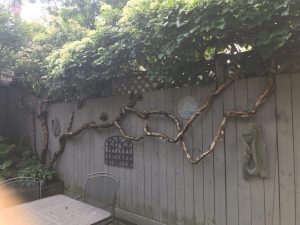
Hello….our wonderful climbing hydrangea is suffering at one end. Suddenly there are wilting leaves. This plant is well over 30 years old. We can’t see any reason for the wilt and wonder if some rodent might be at its roots under a neighbour’s deck; or if some chemicals have been used in another neighbours lawn following an ‘above ground’ pool installation in the past couple of years. I am including a picture of the whole hydrangea and closer views of the affected end. So hoping you’ll have some thoughts that will help. Cheers,
What a spectacular specimen you have. It is no surprise that you wish to ensure that your lovely Hydrangea petiolaris remains in good health.
Wilting in plants is due to a deficiency of water in the leaves and stems. Since this is affecting only a part of your plant, it is not likely to be a disease such as phytophthora root rot, which causes yellowing foliage in addition to wilting leaves and would affect the whole plant. You mention the possibility of chemical damage: non-selective herbicides can certainly cause accidental injury to leaves of adjacent plants – you would expect to see yellowing and die-back. The effect of chlorinated water on plants (from a pool, as you mention) would typically be curling and scorching of leaves.
Although there are several insect pests that can affect hydrangeas, as well as bacterial and fungal diseases, none of their symptoms are described in terms of the partial wilting that your hydrangea is experiencing.
Have you tried to trace the stem or stems of the wilting portion back to the source? Doing so may show you a broken branch. Climbing hydrangeas can become brittle and top heavy, as you probably know, and they can be easily damaged. Is it possible that this is what has happened in your case?
If a branch of your hydrangea is dying back, it is important in any case to prune those damaged branches as soon as possible in order to ensure that the remaining part of the plant remains healthy: the stressed parts of a plant are more vulnerable to both insect pests and disease that can then affect the plant as a whole.

